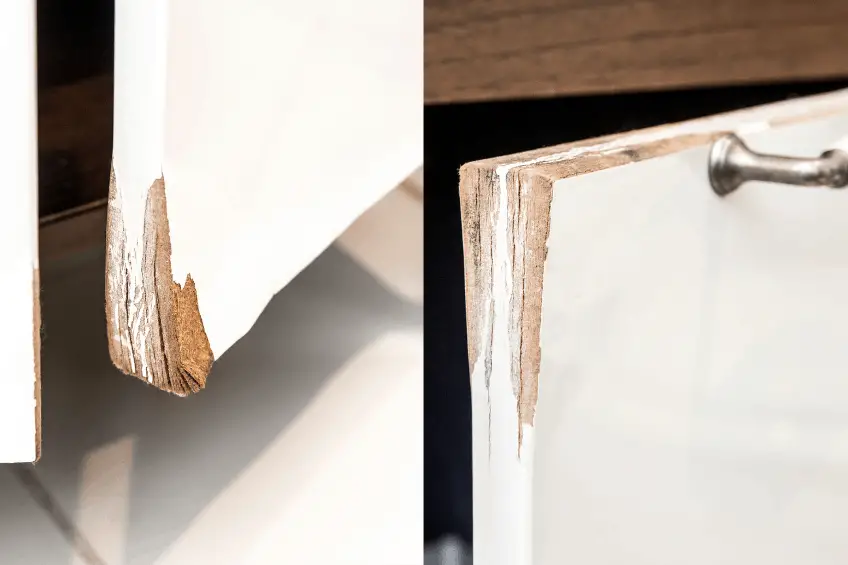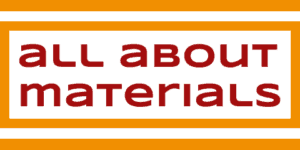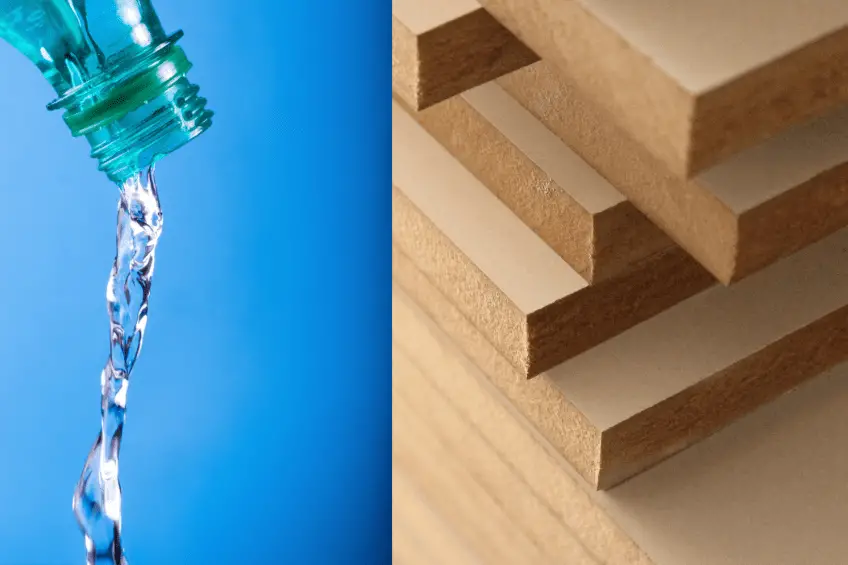This post contains affiliate links.
MDF is a very versatile material and it has been widely used in making furniture, cabinets, shelves, and finishing material as an alternative to plywood and other wood products. It is widely used indoors and mostly placed in dry spaces but is MDF waterproof? And can you use it outside?
Standard MDF is not waterproof or water-resistant, and it will absorb water like a sponge. When it gets wet it will swell, and becomes almost useless. There are, however, moisture-resistant and waterproof MDF that resists moisture to a high degree but will cost more than standard MDF.
Moisture-resistant and waterproof MDF products cost almost double the price of standard MDF. The benefits of being moisture resistant, especially using it in areas with high moisture exposure, outweighs the high cost you would have to put out initially. There are, however, things you can do to seal and protect standard MDF from moisture if you only need minimal protection and if you are on a tight budget.
Can MDF Get Wet?
From wall paneling, trims, baseboards, and mouldings, to cabinets and shelves, countertops, and doors, MDF is considered a very versatile material that is becoming widely used inside our homes. Most of these products use a standard type of MDF which is being used as a good alternative to plywood and other wood products. Standard MDFs are usually used indoors, and placed far away from any exposure to water.
Standard MDF can get wet and get damaged by water and high moisture in the air just like most wood products. It does not hold up to water very well. Because of how standard MDF is made, it sucks moisture like a sponge, and will swell, distort, and almost become useless if not treated or sealed.
Can Painted MDF Get Wet?
Applying sealers, and paints to MDF can offer it surface protection but does it also offer protection against water and moisture? Can painted MDF still get wet and get damaged?
Painted MDFs will have some level of moisture resistance but only at surface level. As long as moisture-resistant paint was used, and remains intact, MDF will not get wet and will remain protected from moisture. If the paint surface somehow breaks, however small that break may be, water will be able to pass through, enough for the MDF to absorb it. Once that happens, the MDF will start to swell and break down.
Even with a remarkable painting job, MDF may be exposed to temperature and humidity changes. This can cause the MDF to contract and expand which will affect the painting job as well. Over time, the regular expansion and contraction of the MDF material could create small breaks in the paint surface, which will then expose MDF to moisture.
It is better and more practical to use mr MDF instead of standard MDF if you plan to use it in wet or semi-wet areas. Although paint will give standard MDF moisture protection initially, you would need to reapply paint to the MDF just to make sure that any possible breaks on the previous seal or paint will be patched up.
Is MR MDF Waterproof?
MR MDF or moisture-resistant MDF is a special grade MDF that was made to resist extreme moisture and humid conditions. They are also known as green MDF since most mr MDFs are given a green core color for easy identification. Not all mr MDF are colored green though with some manufacturers of moisture-resistant MDFs still retaining the usual brownish color of MDF.
In areas such as basements, garages, and even areas outside that are partially exposed to rain or snow, standard MDFs would fail miserably. In areas such as these, mr MDFs are recommended to be used.
Are mr MDF waterproof? Not all mr MDF are completely waterproof. Most of them have a high resistance to moisture and will not swell or distort with occasional exposure to extreme moisture or humidity but they can still get damaged when they get soaked for a long time.
Although most of them are considered as exterior grade MDFs and some manufacturers claim their products to be waterproof, you should still be cautious in using mr MDF in areas that can get submerged or soaked in water or moisture for a long time. They still need to be sealed and painted to give them additional protection against moisture.
In most cases moisture-resistant MDFs are very good to use in high moisture and humid areas such as in bathrooms, or in basements. As long as the mr MDF will not get soaked for too long, it will hold up to moisture well, better than standard MDF.
Some mr MDF product names that are available in the US include Extira, Armorite, Medex, and Medite MR MDF. They are all moisture-resistant MDFs that can be used in areas that are exposed to high moisture and humidity levels.
Is There a Waterproof MDF?
There are a couple of manufacturers claiming to have their moisture-resistant MDFs or exterior grade MDFs to be completely waterproof but a few tests are available for us to confirm their claims. So, is there even such a thing as waterproof MDF?
There is one MDF product that has been getting traction online because of its good waterproof qualities. This product is by Medite and their product’s name is Tricoya Extreme. Aside from their waterproof claim to their product, Medite’s Tricoya Extreme has a 50-year warranty when used above ground and a 25-year warranty when used below ground giving anyone enough confidence to use these in extreme wet conditions.
Here’s a video from Youtube comparing and testing Medite Tricoya Extreme MDF to another moisture resistant MDF. As seen in the video, after 24 hours submerged in water, the mr MDF swelled and distorted while the Tricoya Extreme MDF stayed the same thickness.
Here’s another video showing Tricoya Extreme MDF being used outside a house. The video also showed a test where it submerged the Tricoya Extreme MDF underwater for 3 weeks and it didn’t show any changes dimensionally. If there is one waterproof MDF product in the market that you could use in areas exposed to extreme moisture and humidity, the Tricoya Extreme MDF would be one of them.
What Happens When MDF Gets Wet?
When standard MDF gets wet, it will soak up and absorb water or liquid like a sponge. It will swell and get soft over time until the damage becomes irreversible. As soon as you see the MDF soaking up liquid, you should try to remove it away from the liquid, or wipe off the liquid dry, to prevent the MDF from getting damaged further.

MR MDF or moisture-resistant MDF will hold up better against moisture exposure than standard MDF and will not swell and get soft and damaged as easily. If an mr MDF gets wet, you wouldn’t see any visible damage similar to how standard MDF will become affected when it gets wet.
Below is a Youtube video comparing plywood, standard MDF, mr MDF, and particleboard against water damage. As seen in the video, the particleboard swelled and sustained the most damage. The standard MDF, though as not as damaged as the particleboard, also swelled a bit when it absorbed the water. Both the mr MDF, and plywood have shown no swelling, though they have absorbed a bit of water as well.
Below is another video showing the effects of standard MDF baseboards when it gets wet and starts absorbing water.
Is MDF Ruined If It Gets Wet?
Standard MDF will not get ruined right away when it gets wet. Although it will swell up when it gets wet, if it has not yet softened up or its wood fibers separating, you can still dry it up, and repair it to looking new again. As soon as you see the MDF swelling or getting soaked in water, remove it away from the water source at once and start doing the appropriate repairs.
Depending on how long, how frequent, and how much of the standard MDF was exposed to moisture, irreparable damage can take hours, weeks, or even months before it happens. The earlier you can get it dry and away from water, the better chances that you could still repair the water-damaged MDF.
What Can You Do if MDF Gets Wet?
Most standard MDFs that get water damaged are used as baseboards, trims, or moulding, even cabinets, and shelves located in the bathroom or under the kitchen sink. Some are even furniture that gets exposed outside. If you know that these items will be exposed to moisture or water, you should know what to do when the MDF gets wet.
Although not exposing it to water and moisture would be the ideal situation, if the MDF was used or is being used in locations or areas where water or moisture is frequently present, all you can do is to be careful not to get it wet or be quick to react if it starts to get soaked.
So what can you do when the MDF gets wet? As soon as you see the MDF gets wet, quickly wipe it off dry before any lasting damage starts to happen. Even if the swelling has already begun, you should still need to wipe off the MDF dry so that you can assess if the damage can still be repaired. If the MDF is not yet too soft, spreading apart, flaking, or crumbling, it could still be dried off and repaired, otherwise, the damage is already irreparable.
How Do You Dry Wet MDF?
As soon as your remove MDF away from the source of water, use absorbent pieces of cloth or even paper towels to absorb the excess water as quickly as possible. You can also try sprinkling baking soda over the area of MDF that got wet. If the MDF soaked a lot of water, you would need to leave the baking soda for at least 24 hours to absorb as much water as it can. Then just brush off the baking soda afterward.
You can also do the following to help dry the wet MDF faster:
- Bring it out to dry in the sun. Just make sure though to bring it inside when you know that it’s going to rain or snow.
- Use a heat gun or hair dryer to help dry out the MDF faster. Just do a slow, and controlled back and forth motion on the areas that got wet.
- If the water-damaged MDF covers a larger area, you can have fans blow air in the room, which will help pick up moisture from the MDF. A more expensive option would be to rent a heat-drying system which will blow hot air into the room. This will be drying the large MDF faster than just using ordinary fans.
One thing to keep in mind though that once MDF swells or distorts, it won’t go back to its original shape even when it becomes dry. You can still sand the swollen or distorted parts flat, as part of its repair work.
How To Repair Wet MDF?
Water-damaged MDF can still be repaired as long as the material is still intact. There should be no visible separation or flaking, and the area that has swollen has not turned too soft. Just keep in mind that MDF that has soaked a lot of water will not be the same. Although the swollen or distorted part can still be sanded down flat, the MDF will be weaker in that area.
Since MDF is used as a material for different types of things like baseboards and trims, doors, and furniture, and a lot more, there may be different or additional steps involved in repairing wet MDF depending on its actual function. In most cases though, the first few steps would be the same for all MDF regardless of their function. Here are the most common steps involved in repairing wet MDF.
- Before starting anything, make sure that the MDF is completely dry. If it’s still wet or damp when you start working on it, you could inflict additional damage to it.
- Once the MDF is completely dry, sand the swollen or distorted areas flat using an orbital sander or a sanding block using a rough grit.
- Wipe off any loose bits in the MDF, making sure that there are no hanging small bits of old caulking or paint before we start filling in the pits and gouges on the surface, and applying the seal and paint.
- Using a wood filler, fill in holes, cracks, pits, and gouges on the surface to make the surface of the MDF smooth and flat again. Then let it dry for around 30 mins. or so before continuing to the next steps.
- Using a sanding sponge, sand the surface smooth.
- Apply one coat of a thin layer of polyurethane sanding sealer, such as the Miniwax sanding sealer, on the surface of the MDF. This will prevent the MDF from soaking the paint and will allow you to apply a few coats of paint finish. Let it dry for about an hour or so before you proceed to paint it.
- Apply 2 coats of moisture-resistant paint to the MDF using spray paint or a brush. Make sure to allow the paint to dry in between coats.
Here’s a video showing one way of repairing a water-damaged baseboard.
Can You Use MDF in Bathrooms?
There are MDFs that are being used inside bathrooms such as for baseboards or as bathroom vanities. Standard types do not hold up well to water but can you use MDF in bathrooms?
A standard MDF can be used in bathrooms, such as a baseboard or part of the bathroom vanity, as long as the MDF is well sealed and painted, and is kept dry. The seal and paint coating should protect the standard MDF for a short while so don’t let it get soaked in water. And always check if you need to reseal or repaint the MDF to keep it protected from moisture.
Ideally, for bathrooms, it is best to use moisture-resistant MDF instead of the standard type MDF. Moisture-resistant MDF will hold up against water better than standard MDF. With or without seal and paint, mr MDFs should be able to last longer in bathrooms than standard MDFs.
Can MDF Be Used Outside?
The standard type MDF is not recommended to be used outside. Even with a good sealed and painted MDF, as soon as the coat of paint breaks and reveals the surface of the MDF, it will start absorbing moisture, which will then lead it to swell and break apart.
If you’re planning on using MDF outside, use an exterior-grade MDF or a moisture-resistant MDF instead. These types should be able to hold up better against exposure to high humidity, rain, or snow.
Can MR MDF Be Used Outside?
Moisture-resistant MDF or mr MDF is made to withstand high moisture and humidity. This includes moisture coming from rain or snow. Not all mr MDF brands are good when completely exposed to extreme weather conditions though. Some are only good outside if it’s semi-exposed with a canopy or shade above it. While some brands, like the Medite Tricoya Extreme MDF can withstand extreme wet and humid conditions, other mr MDFs will still swell and distort when exposed to water for a long time.
It would be best, when choosing a moisture-resistant MDF for exterior use, to test it out first before using it in your own project.
Can MDF Be Made Waterproof?
For areas exposed to extreme moisture and humidity, and you plan on using MDF, the exterior-grade or moisture-resistant types should be used. Moisture-resistant MDF or exterior-grade MDF is almost twice the cost of standard types of MDF. If the moisture-resistant types are above your budget, can you use the standard type MDFs instead? And can you make them waterproof?
A standard type MDF can be made waterproof by applying sealer and moisture-resistant paint. It will remain waterproof as long as the coating remains intact. The moisture protection may just be temporary though as it is just on a surface level. As soon as the coat of paint breaks, the MDF will then become exposed to water and moisture. This will allow water to get absorbed by MDF, which can lead it to swell and get extremely damaged.
All About Materials is a participant in the Amazon Services LLC Associates Program, an affiliate advertising program designed to provide a means for sites to earn advertising fees by advertising and linking to Amazon.com. We also participate in other affiliate programs which compensate us for referring traffic.

